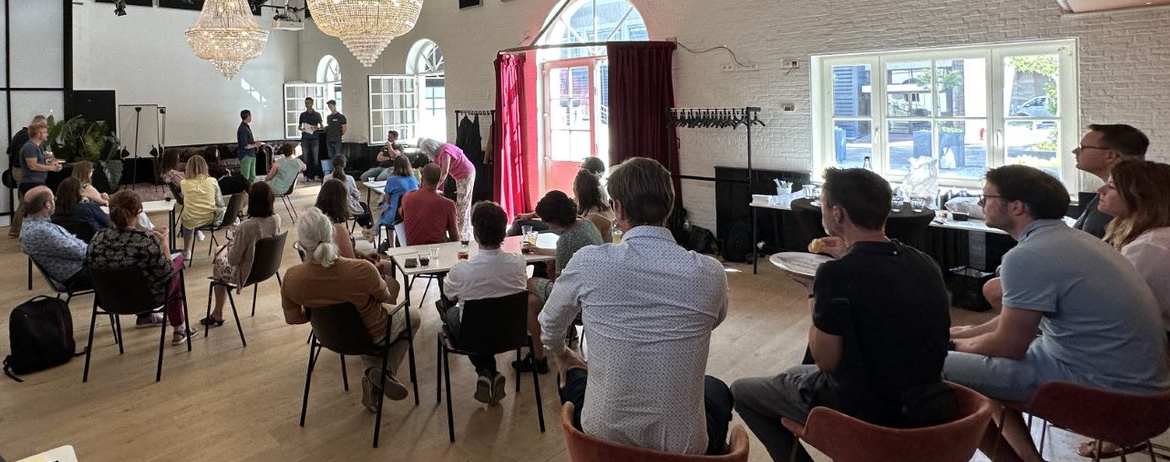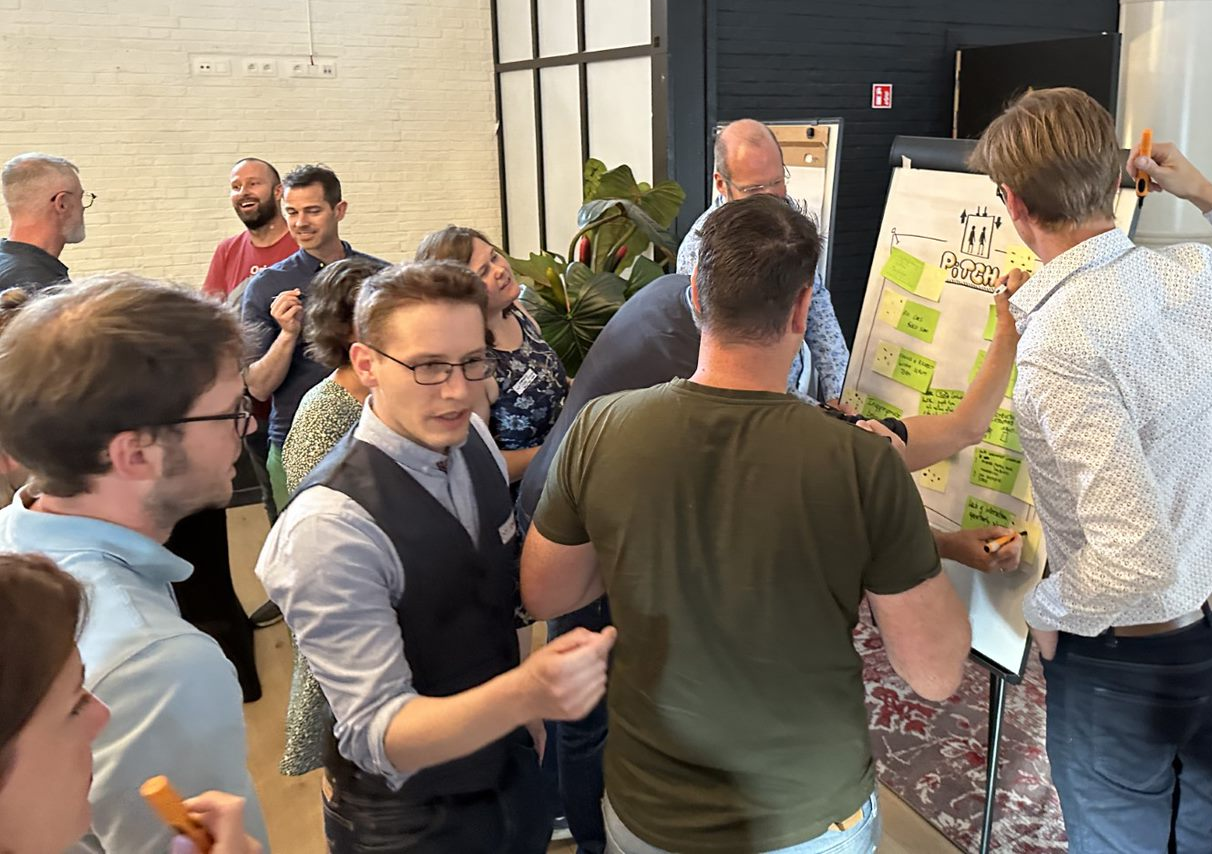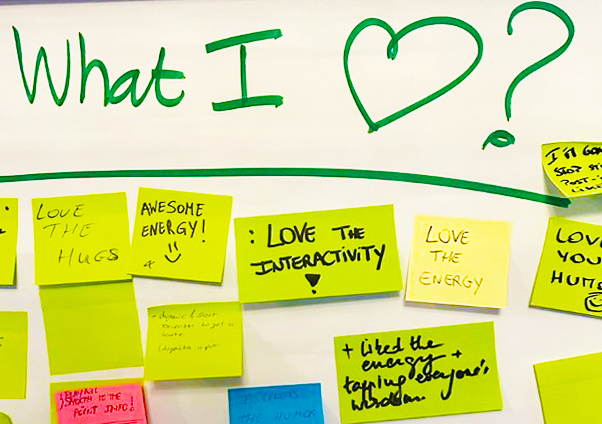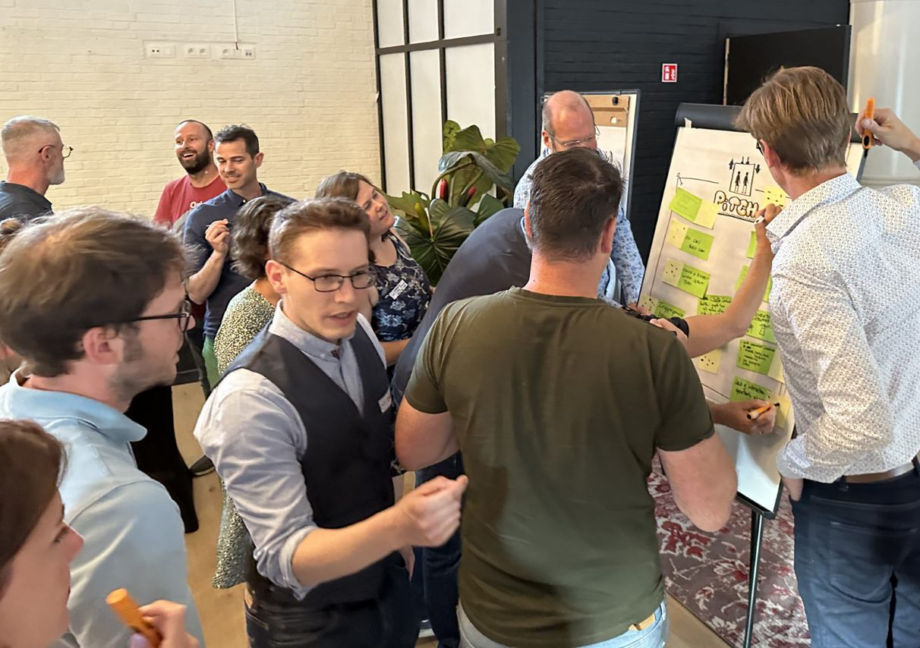On July 12th, our Agile Kitchen was bursting with activity again, with a very interactive and practical session on the art that is facilitation.
We believe sharing is caring, so we want to share a short summary of this free Agile Kitchen session in case you missed it or want to go over it again.
Artur Margonari and Johan Decoster, both very seasoned facilitators, treated our participants to a mix of some theory and very interactive group work, resulting in tons of practical tips and tricks to take your facilitation skills to the next level.

Fresh air
After a short introduction by iLean’s Vincent Vanderheeren, Artur and Johan invited participants to step outside into the fresh air for a great check-in to get to know each other through a constellations exercise.

This warm-up was the starting point of what turned out to be an immensely interactive Agile Kitchen session, with even a musical addition to the evening through Artur’s ukelele.
Both Artur and Johan presented a facilitation mistake they had made in the past and invited the participants to share what they think they could have done to avoid this mistake. This helped participants to get into the reflective flow needed for the intensive group work.
Group work
Johan and Artur asked the audience to self-organize into groups of 3, preferably with different levels of facilitation experience, and to choose a facilitator. Each group discussed past facilitation mistakes and future challenges within a set timeframe and reflected on what could have been done differently, and shared advice and experiences.
When asked what was the hardest part of this exercise, turned out that most facilitators struggled with:
- Not getting carried away with the conversation and losing track of time
- Simultaneously participating and facilitating
- Timeboxing for complex explanations
- Deciding on which case to present to the full group
After this group work, a scenario was selected to act out with the full group, namely, the scenario of a Retrospective where you get little or no input from participants. First, the bad scenario was acted out, and then an example of better facilitation was presented.

Tons of practical tips and tricks
Participants left this session with tons of practical and applicable tips and tricks, and we are very happy to share some of them here. As you can see, it is quite an extensive list, thanks to a very productive evening! Here goes:
- Know your audience: background, culture, sensibilities, …
- Apply humor, and crack a joke when you make a mistake.
- Always lead by example: if you want people to open up and be vulnerable or to give honest feedback, make sure to do so yourself first.
- Be careful with open conversations: be aware that only the vocal minority might contribute.
- When voting on a decision, make sure to agree on the parameters used for the voting and give people room to explain why they voted for this or that option.
- Be aware that dot voting can become very strategic very fast. The first voter influences everyone else, and the last voter can swing the vote. An alternative is to have everyone make their decision and let them put the dots on their choices simultaneously.
- If you have to tally votes (e.g., when dot-voting), have a few audience members do it for you. If you turn your back to the group to do it yourself, you will lose their attention.
- Liberating structures such as 1-2-4-all allow less vocal people´s voices to be heard as well.
- Agree upfront that when you raise your hand, people who notice should finish their sentence and raise their hand (and be quiet) as well. This is a fast way to get everyone´s attention without interrupting them abruptly.
- When you have the floor but the group is still chattering or restless, lower your volume. People will become quiet yet still be able to hear you.
- If you have to participate at some point, ask someone else to take over (part of) facilitating for a while.
- Decisions don´t always have to be a majority vote. There is also flipping a coin, deciding on different criteria and then awarding points for those categories, consent forming, and north star voting.
- Post-it tips: remove the Post-it by pulling it downwards, to avoid bending it. And write in all caps, using the full Post-it.
- Popcorn: to know when you can interrupt/stop a group conversation, listen for the ´pops´: you know they are done when there are only a few remarks here and there.
- If you have a good reason for not following the group vote, make sure you explain why to the group.
- Thank the group for participating. This way, they are more likely to do it again.
- Get out of the way when facilitating so people talk to each other instead of you.
- Make your questions as specific as possible: e.g., in a Retro avoid general questions such as ´What happened during the last Sprint?’
- The energy of the facilitator influences the energy of the group
- If you thank someone for doing something, remember to thank everyone who does it. Better yet, thank the group and not specific people.
- If you do a Retro, try to do a Retro of the Retro during the last 5 minutes. Techniques such as ROTI (Return on Time Invested) or Retro targets are very useful in that context!
As you can see, this Agile Kitchen session was packed with useful tips and insights to make facilitation even more effective and fun!

Check out our Agile Kitchen calendar, and make sure to claim your seat for our following session!
Are you eager to know more about all things Agile, and are you looking to gain more insights and share experiences and challenges with your peers? Check out our Agile Kitchen calendar, and make sure to claim your seat for our following session!


